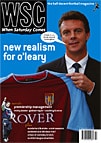 Ian Plenderleith is intrigued by a tale of orchard murder in the Scottish Borders and other football badges in this month’s internet review, but is a touch less impressed by academic obsessions
Ian Plenderleith is intrigued by a tale of orchard murder in the Scottish Borders and other football badges in this month’s internet review, but is a touch less impressed by academic obsessions
Just when you’re ready to give up and log off for good to go and do something worthwhile with your life, like recycling old cereal boxes for homeless hamsters, along comes a site that makes you remember why the internet has all been worthwhile. Press ‘Forward’ to July’s site of the month, Footballcrests.com.
This domain explains football club crests. What they symbolise, how they relate to their towns, when they were designed and the histories of previous logos. It is sporting social history (see, for example, how the crest of Leyton Pennant reflects the amalgamation of non-League clubs in East London), a settler of classic pub disputes, and a fount of genuinely fascinating information. Take Gala Fairydean FC, for instance.
“The crest of Gala Fairydean FC is based on the town crest of Galashiels, which shows two foxes trying to reach ripe fruit on a plum tree,” the site explains. “This depicts an event of 1337 when, during a border battle between the Scots and English, a few English soldiers are said to have strayed from their main troop to gather plums.” Some locals spotted them, slaughtered them, and chucked their bodies into a trench at the Eastlands, which was later to become one of Gala Fairydean FC’s home grounds.
It adds that the motto on the club crest displays the club name, but that on the town crest it reads “Sour Plums”. Which is a shame, as The Sour Plums would surely be a great nickname for a football team somewhere, if not in Galashiels.
Also featured are the spoof club crests proposed by Charlton on its website on April Fools’ day last year, which caught out several hundred fans; more about Hailsham, ropes and martlets than you’ll ever need to know; and a non-UK clubs section showing us designs as varied as the sand-crab crest of Deception Bay in Australia and the 13th century tower logo of GKS Pliast Giliwice in Poland. It is continuously expanding, but a big black crest of meanness and misery must be awarded to the many teams who have refused to allow the site to reproduce their club logos.
Vaguely connected, possibly less informative, but no less entertaining, is Soccer and Society, a homepage to publicise the academic journal of the same name. You need to subscribe to access the journal’s contents, but the summaries (or rather, the “abstracts”, which turns out to be a far more appropriate word) of the articles contained in the publication should give you an idea of what to expect, if the titles themselves haven’t already done so.
For example, in issue 3.3 (don’t ask), the essay Finnish Soccer Supporters Away from Home: A Case Study of Finnish National Team Fans at a World Cup Qualifying Match in Liverpool, England apparently came to the astonishing conclusion that Finnish fans behaved in a “carnivalesque” fashion on the day.
Meanwhile, Soccer and Kinship in Argentina: The Mother’s Brother and the Heritage ofIdentity, explains how “the analysis of the relationship between football and kinship not only considers the role of general social processes such as those relating to machismo but also other esoteric characteristics of football ritual in order to provide a structural explanation of the transmission of football passions in the societies of the River Plate in Argentina.” You’d think a writer so keen on structural explanations would know where to shove in a comma every now and then.
If that’s not your bag, try the more appealing Hooligans and Barrackers: Crowd Disorder and Soccer in South Wales, c.1906-39, or my personal favourites, The Hooligan’s Fear of the Penalty, and Taking Offence: Modern Moralities and the Perception of the Football Fan, which seeks to highlight how “the recasting of football deviancy is representative of an authoritarian transformation of the relationships between State power and the individual”.
To be fair, only the most extreme examples of masturbatory proselytising have been picked out here, and some of the pieces look genuinely interesting. However, one such piece, Racism in Football: A Victim’s Perspective, posits the barely revelatory conclusion that “there is still a long way to go in the quest to rid football of racist attitudes”. Perhaps they’d be better just skipping the analysis and producing a fanzine instead. Still, at least Soccer and Society can claim to have outlasted both Match of the Day and Total Football magazines.
From WSC 197 July 2003. What was happening this month